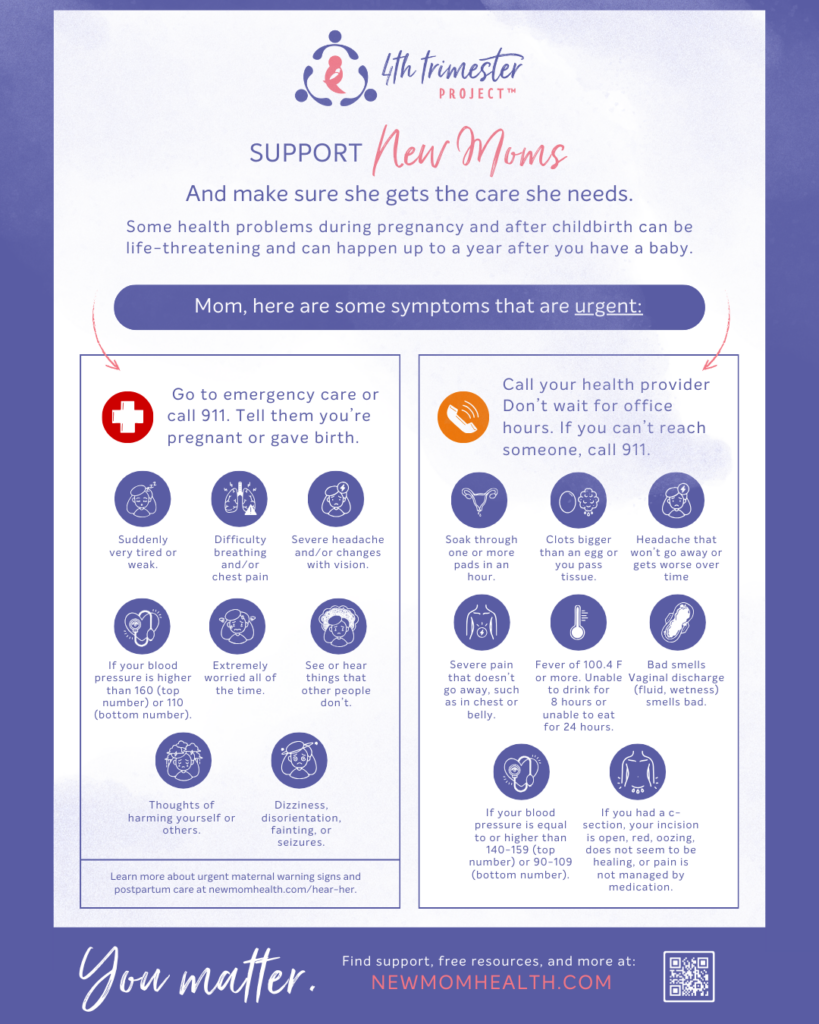
Birthing a baby vaginally is not easy. Perineal pain due to episiotomy, tears, stitches, or just the stretching of vagina during birth is very common. If you had a tear and stitches, it can be especially painful for the first week or two. Fortunately, vaginal tissue has a great blood supply and will generally heal quickly. Some women are nervous about peeing right after they have a baby, especially if they had stitches. That is understandable and normal. Using a squirt bottle with warm water (peribottle) before you pee can help.
If your pain worsens and isn’t relieved by the tips below, contact your provider.
If you experience any of the following, don’t wait for office hours. If you can’t reach someone, call 911.
- Bleeding Soak through one or more pads in an hour.
- Clots bigger than an egg or you pass tissue.
- Severe pain that doesn’t go away, such as in chest or belly.
- Bad smells Vaginal discharge (fluid, wetness) smells bad.
This is just some of the signs you may experience related to your vaginal healing. There are some urgent maternal health warning signs that can happen up to a year after childbirth. Be sure you recognize ALL of the warning signs and symptoms.
If you are continuing to experience pain at four-six weeks postpartum, your provider should check to make sure there is not a problem with the healing process.
Things to do that might help
- During the first 24 hours most women find it helpful to apply ice packs to their bottoms which not only helps with pain but can reduce swelling in the area. Cabbage leaves can also help reduce swelling. At home, some moms find to helpful to make “padsicles” by spraying pads with witch hazel and then putting them in the freezer.
- After 24 hours women may find comfort in warm compresses, soaking the vulvar/perineal area in warm (not hot) water in the bathtub, or using a sitz bath, a special tub that can be placed on the toilet to wash warm water over your bottom.
- To relieve the stinging that can occur as urine comes in contact with stitches or small tears, you can keep a squirt bottle with warm water in the bathroom and use it to spray on your bottom when you pee.
- To relieve some of the pressure on your bottom you might want to sit on a rubber ring or hemorrhoid pillow. Sitting in a slightly reclined chair can also take the pressure off.
- It is important to avoid constipation as straining during bowel movements may be painful. Drink plenty of water, move around as much as you can, and eat a balanced diet that includes fruits, vegetables and fiber. A stool softener can help with constipation.
- Unless advised otherwise by your doctor, you can take some Ibuprofen (like Motrin(TM) and Advil(TM)) to help with the pain. In the days immediately following birth, you could rotate between Ibuprofen and Acetaminophen (like Tylenol(TM)) every four hours to help.
- Squirt bottles (peribottles) with warm water, sitz baths, and alternating ice packs with warm tub soaks can all help heal sore bottoms.
There are a variety of herbal products and creams on the market. There isn’t strong evidence that products meant to provide local anesthesia to the bottom are helpful for perineal pain after childbirth. This doesn’t mean that it might not work for some women. If you want to try it and have sensitive skin, you might want to test it on your wrist and then wait 24 hours to make sure you’re not allergic to it. Here is a scientific blog about perineal pain help. This is a blog on herbs – it is old and doesn’t reference peer-reviewed literature but it might be of interest. More research is needed to help women with pain!
Additional Resources to Explore:














